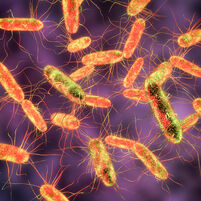Monitoring of foodborne diseases


Zoonotic diseases are infections or diseases that can be transmitteddirectly or indirectly between animals and humans, for instance by consuming contaminated foodstuffs. Common foodborne zoonotic A term given to diseases and infections that can be transmitted between animals and humans. diseases in the European Union (EU) are caused by bacteria such as Campylobacter and Salmonella.
Data collection is imperative to identify which animals and foodstuffs are the main sources of infections and to monitor the prevalence The proportion of a population found to have a condition. of zoonotic diseases. Data analysis helps prevent and reduce the impact of zoonoses in the food chain. For this purpose, information on foodborne zoonotic diseases aimed at protecting human health is collected and analysed from all EU Member States.
Latest
In 2022 there were 5,763 foodborne outbreaks in the EU – a 44% increase compared with 2021. See the latest annual EU One Health Zoonoses report by EFSA and ECDC.
EFSA has updated its interactive tools on foodborne outbreaks – a story map and a dashboard. The story map provides general information on foodborne outbreaks, their causative agents and implicated food. The dashboard allows users to search and query the large amount of data EFSA has collected from EU Member States and other reporting countries since 2016.
EFSA's role
EFSA monitors and analyses the situation on zoonoses, zoonotic microorganisms, antimicrobial resistance The ability of microbes to grow in the presence of substances specifically designed to kill them; for example, some human infections are now resistant to antibiotics, raising concerns about their widespread use., microbiological contaminants and foodborne outbreaks across Europe. The Authority is assisted by the Network for zoonoses monitoring data, a pan-European network of national representatives and international organisations that assist EFSA by gathering and sharing information on zoonoses in their respective countries.
Annual summary reports on zoonoses and foodborne outbreaks in the EU
Based on data collected by the EU Member States, EFSA produces in cooperation with the European Centre for Disease Prevention and Control (ECDC) annual summary reports on zoonotic infections and foodborne outbreaks. These reports illustrate the evolving situation in Europe regarding the presence of zoonotic microorganisms in the food chain and the prevalence of animal and human infection as well as disease outbreaks caused by consuming contaminated food.
EFSA reviews the annual reports and makes recommendations on prevention and reduction measures. Together with ECDC, EFSA’s Panel on Biological Hazards and the Panel on Animal Health and Welfare have provided recommendations on preventing and reducing zoonotic diseases in humans and animals including salmonellosis, campylobacteriosis, listeriosis and toxoplasmosis.
EFSA also gives guidance to national authorities on how to carry out monitoring and reporting activities on zoonoses, foodborne outbreaks and antimicrobial resistance.
EU-wide baseline survey reports
The prevalence of foodborne zoonotic microorganisms is monitored throughout the European Union. EU-wide baseline surveys are carried out to obtain fully comparable figures of the prevalence of zoonotic microorganismsin food and animals (such as chickens, turkeys and pigs) at a specific point in time. EFSA analyses and publishes the results of these surveys covering the prevalence of Salmonella, Campylobacter and Meticillin-resistant Staphylococcus aureus among others.
The baseline survey results are published in two parts: the first part assesses the prevalence of the zoonotic microorganism, e.g. Salmonella, in a certain animal population Community of humans, animals or plants from the same species.; the second analyses the risk factors that contribute to the prevalence of that microorganism in the specific animal population.
EFSA’s findings are used by risk assessors to provide risk estimates and by risk managers in the EU and the Member States to define possible control options and/or reduction targets.
EU framework
The monitoring and control of foodborne diseases as well as food hygiene requirements and food safety criteria are regulated by EU legislation.
For details on the regulatory framework, see: foodborne zoonotic diseases.













